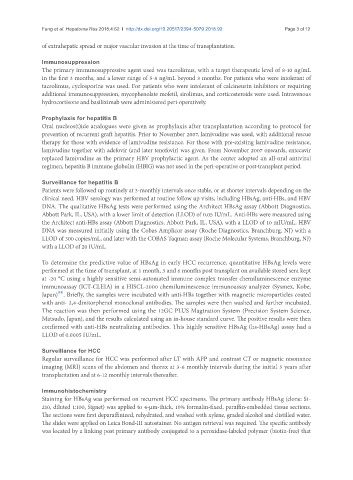Page 690 - Read Online
P. 690
Fung et al. Hepatoma Res 2018;4:62 I http://dx.doi.org/10.20517/2394-5079.2018.92 Page 3 of 12
of extrahepatic spread or major vascular invasion at the time of transplantation.
Immunosuppression
The primary immunosuppressive agent used was tacrolimus, with a target therapeutic level of 8-10 ng/mL
in the first 3 months, and a lower range of 5-8 ng/mL beyond 3 months. For patients who were intolerant of
tacrolimus, cyclosporine was used. For patients who were intolerant of calcineurin inhibitors or requiring
additional immunosuppression, mycophenolate mofetil, sirolimus, and corticosteroids were used. Intravenous
hydrocortisone and basiliximab were administered peri-operatively.
Prophylaxis for hepatitis B
Oral nucleos(t)ide analogues were given as prophylaxis after transplantation according to protocol for
prevention of recurrent graft hepatitis. Prior to November 2007, lamivudine was used, with additional rescue
therapy for those with evidence of lamivudine resistance. For those with pre-existing lamivudine resistance,
lamivudine together with adefovir (and later tenofovir) was given. From November 2007 onwards, entecavir
replaced lamivudine as the primary HBV prophylactic agent. As the center adopted an all-oral antiviral
regimen, hepatitis B immune globulin (HBIG) was not used in the peri-operative or post-transplant period.
Surveillance for hepatitis B
Patients were followed up routinely at 3-monthly intervals once stable, or at shorter intervals depending on the
clinical need. HBV serology was performed at routine follow up visits, including HBsAg, anti-HBs, and HBV
DNA. The qualitative HBsAg tests were performed using the Architect HBsAg assay (Abbott Diagnostics,
Abbott Park, IL, USA), with a lower limit of detection (LLOD) of 0.05 IU/mL. Anti-HBs were measured using
the Architect anti-HBs assay (Abbott Diagnostics, Abbott Park, IL, USA), with a LLOD of 10 mIU/mL. HBV
DNA was measured initially using the Cobas Amplicor assay (Roche Diagnostics, Branchburg, NJ) with a
LLOD of 300 copies/mL, and later with the COBAS Taqman assay (Roche Molecular Systems, Branchburg, NJ)
with a LLOD of 20 IU/mL.
To determine the predictive value of HBsAg in early HCC recurrence, quantitative HBsAg levels were
performed at the time of transplant, at 1 month, 3 and 6 months post transplant on available stored sera kept
at -20 °C using a highly sensitive semi-automated immune complex transfer chemiluminescence enzyme
immunoassay (ICT-CLEIA) in a HISCL-2000 chemiluminescence immunoassay analyzer (Sysmex, Kobe,
[18]
Japan) . Briefly, the samples were incubated with anti-HBs together with magnetic microparticles coated
with anti- 2,4-dinitorphenol monoclonal antibodies. The samples were then washed and further incubated.
The reaction was then performed using the 12GC PLUS Magtration System (Precision System Science,
Matsudo, Japan), and the results calculated using an in-house standard curve. The positive results were then
confirmed with anti-HBs neutralizing antibodies. This highly sensitive HBsAg (hs-HBsAg) assay had a
LLOD of 0.0005 IU/mL.
Surveillance for HCC
Regular surveillance for HCC was performed after LT with AFP and contrast CT or magnetic resonance
imaging (MRI) scans of the abdomen and thorax at 3-6 monthly intervals during the initial 5 years after
transplantation and at 6-12 monthly intervals thereafter.
Immunohistochemistry
Staining for HBsAg was performed on recurrent HCC specimens. The primary antibody HBsAg (clone: S1-
210, diluted 1:100, Signet) was applied to 4-µm-thick, 10% formalin-fixed, paraffin-embedded tissue sections.
The sections were first deparaffinized, rehydrated, and washed with xylene, graded alcohol and distilled water.
The slides were applied on Leica Bond-III autostainer. No antigen retrieval was required. The specific antibody
was located by a linking post primary antibody conjugated to a peroxidase-labeled polymer (biotin-free) that

